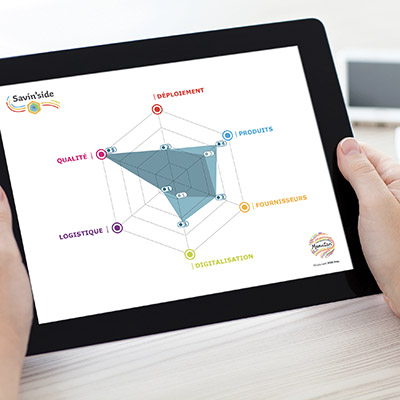Faced with challenges of performance, sustainability, and cost management in the supply chain, vendor managed inventory (VMI) emerges as a strategic solution. By entrusting stock management to their supplier, companies gain visibility, responsiveness, and efficiency. This model fits perfectly within a Lean Procurement approach and can be powerfully enhanced by innovative services. Let's explore together how VMI works, its advantages, the key steps for successful implementation, and the challenges to anticipate.
Vendor Managed Inventory: definition and operating principles
To fully understand the strategic value of vendor managed inventory, it's necessary to revisit its definition, practical operations, and role in a Lean Procurement approach.
VMI definition
Vendor managed inventory is a collaborative model in which the supplier takes charge of stock management at their customer's premises. In practical terms, it's the supplier who monitors, anticipates, and decides on replenishments, drawing on shared data such as actual consumption, sales history, or forecasts.
This management approach differs fundamentally from traditional inventory management methods. In a conventional model, the customer places orders as soon as they identify a need. With VMI, the supplier is proactive: they become responsible for stock levels and take the initiative for delivery, often without prior formal orders.
Vendor managed inventory addresses all companies with recurring or critical flows, particularly in manufacturing, retail, and public services. It's especially relevant when volumes are high, turnover is regular, or supply continuity is strategic.
The expert’s opinion
"Rather than delivering to our customers every day, as marketplaces do, we propose arranging a weekly—or fortnightly—appointment so that a single lorry carries out the delivery. This is an essential approach, both to reduce our carbon footprint and protect the planet, but also for its social benefits." — Xavier Laurent, Director of Mergers and Acquisitions, Manutan[1].
How does VMI work?
At the heart of VMI lies electronic data interchange. The customer shares reliable and up-to-date information (sales, consumption, critical thresholds), which the supplier analyses to adjust deliveries. This transparency requires a relationship of trust and strong coordination.
The process is often automated through EDI solutions, ERP software, or collaborative platforms, enabling increased responsiveness and better decision tracking.
VMI as a building block of Lean Procurement
This model fits perfectly within a Lean Procurement approach: VMI helps reduce excess storage, eliminate waste, and improve logistics flows.
VMI is a powerful driver of sustainable performance. It facilitates standardisation of requirements, rationalisation of procurement, and predictive management, serving a supply chain that's more fluid, economical, and responsible.
What are the advantages of vendor managed inventory?
Vendor managed inventory isn't limited to a simple stock management tool: it's a lever for overall performance. Its benefits touch customers, suppliers, and society as a whole.
Benefits for client companies
For companies, vendor managed inventory provides a concrete solution to supply chain uncertainties. By entrusting stock management to their suppliers, they significantly reduce the risk of stockouts whilst avoiding costly and cumbersome excess inventory.
This model also delivers efficiency gains: teams no longer need to worry about recurring orders or urgently manage unexpected procurement. The supplier, being better informed, stocks items smoothly and proactively. This translates into operational time savings, reduced administrative tasks, and ultimately, economies of scale.
Another notable advantage: logistics optimisation. VMI features delivery planning, reducing the number of shipments and associated costs.
The expert’s opinion
"A customer who orders five packages a day from me... if I'm not careful, we send five different lorries. You have to be vigilant and think of solutions to optimise that." — Xavier Laurent, Director of Mergers and Acquisitions, Manutan[2].
Benefits for suppliers
From the suppliers' perspective, vendor managed inventory facilitates better demand forecasting. By analysing real-time data, they can adapt their production, secure their flows, and optimise their delivery routes.
This model also fosters strengthened commercial relationships: transparency in exchanges and mutual trust create lasting partnerships. The supplier becomes a strategic player in their customer's performance, which reinforces their added value and customer loyalty.
Positive environmental and social impact
VMI also fits within a responsible approach. By consolidating shipments and reducing unnecessary journeys, VMI can help limit COâ‚‚ emissions.
This more sustainable logistics organisation also benefits employees and the local area: fewer lorries means greater safety, less noise, and better quality of life.
The expert’s opinion
"Tomorrow's supply chain will integrate a circular dimension. Faced with procurement problems, part of the answer could lie in a new way of using products, seeking to reintroduce them into the circuit." — Richard Viot Coster, CEO and Co-founder, SNEXT[3].
Implementing vendor managed inventory: key steps, challenges, and solutions
Implementing a high-performing vendor managed inventory relies on a structured and progressive approach.
Steps for implementing high-performing VMI
The first step involves conducting a thorough audit of the existing situation:
- Flow mapping;
- Identification of fast-moving products;
- Analysis of volumes, breakage points, and order cycles.
This phase enables selection of the most relevant product families for VMI.
It's then essential to choose suitable logistics partners and suppliers with whom a relationship of trust can be established. Contractualising commitments (restocking frequency, safety thresholds, performance indicators) structures this collaboration.
Operational deployment relies on robust technological tools:
- Shared dashboards;
- EDI systems;
- Collaborative platforms.
These tools facilitate real-time information flow, stock visibility, and automated replenishment decisions.
Case study: successful implementation in the B2B sector
Let's now consider the example of an industrial company specialising in multi-site production facility maintenance, faced with recurring problems of stockouts and overstocking on fast-moving items. The company decided to implement vendor managed inventory in collaboration with its main supplier, following a continuous optimisation approach.
The first step involved an in-depth analysis of consumption flows across all sites. This work identified 500 critical references, distributed across different technical services and workshops, representing a significant volume of recurring purchases. These products were prioritised for integration into the VMI system.
Next, a digitalisation process was implemented:
- Deployment of consumption sensors;
- Connection to existing ERP tools;
- Creation of customised dashboards to monitor stock levels in real time.
Thanks to these systems, consumption data is now automatically transmitted to the supplier, who adjusts replenishments proactively, without manual intervention from the customer.
Order automation, coupled with optimised logistics planning, has halved the frequency of weekly deliveries. Previously fragmented deliveries have been consolidated into regular, shared rounds, significantly reducing journeys and associated costs.
The results are significant:
- 45% reduction in stockouts;
- Notable improvement in internal user satisfaction;
- Reduction in transport costs;
- Better visibility of consumption.
This case illustrates VMI's potential to transform procurement management whilst strengthening resilience and sustainability.
Challenges encountered and solutions provided
Implementing vendor managed inventory also involves overcoming certain challenges. The first is internal change management: teams must adapt to a new management approach and greater interconnection with suppliers.
[1] Xavier, LAURENT (Director of Mergers and Acquisitions, Manutan), Le débat, SMART @WORK, 05 December 2020, 27 min, B-Smart, [https://www.bsmart.fr/video/2063-smart-work-emission-05-decembre-2020]
[2] Xavier, LAURENT (Director of Mergers and Acquisitions, Manutan), Le débat, SMART @WORK, 05 December 2020, 27 min, B-Smart, [https://www.bsmart.fr/video/2063-smart-work-emission-05-decembre-2020]
[3] Richard, VIOT COSTER (CEO and Co-founder), Le débat, SMART @WORK, 16 October 2021, 22 min, B-Smart, [https://www.bsmart.fr/video/9319-smart-work-partie-16-octobre-2021]









